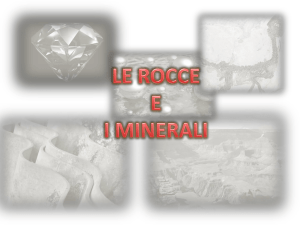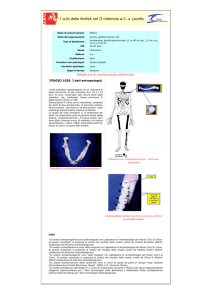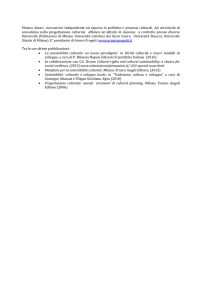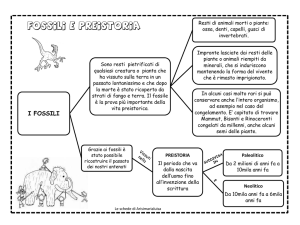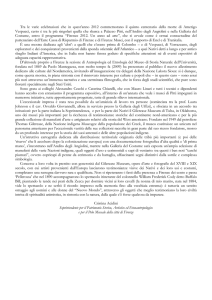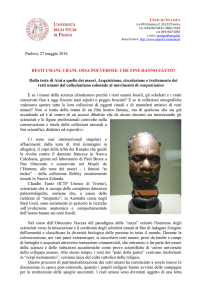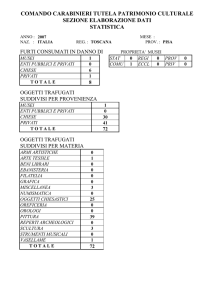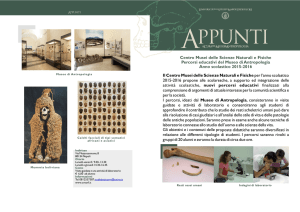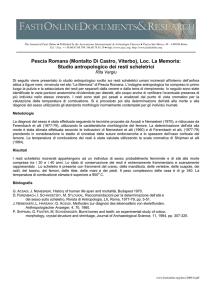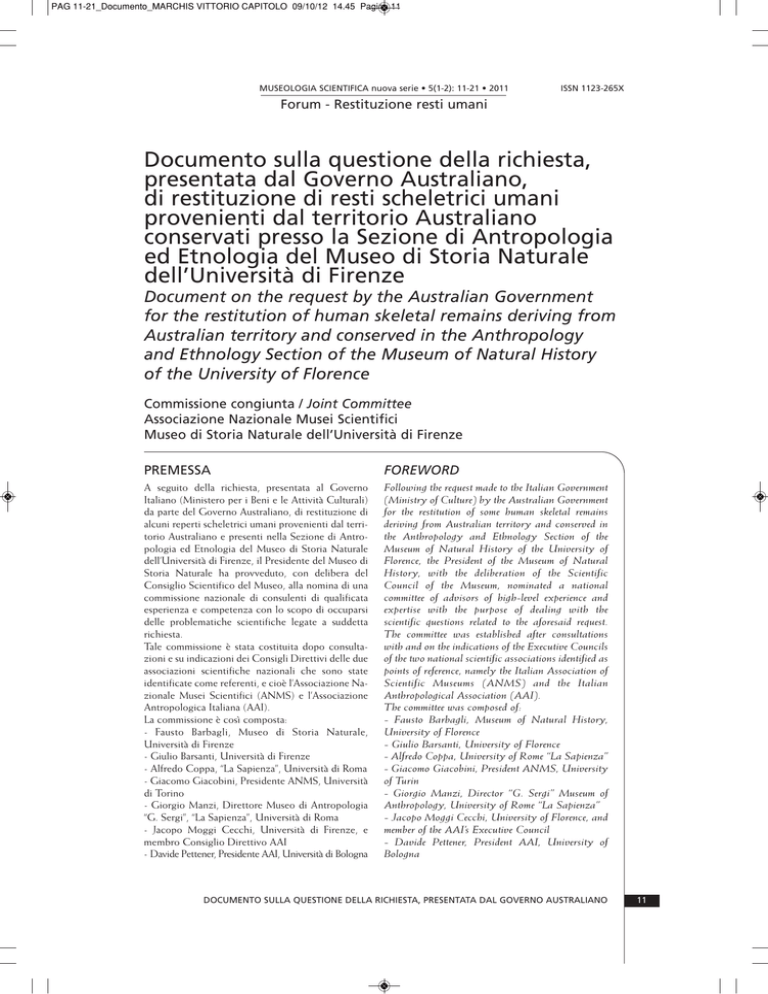
PAG 11-21_Documento_MARCHIS VITTORIO CAPITOLO 09/10/12 14.45 Pagina 11
MUSEOLOGIA SCIENTIFICA nuova serie • 5(1-2): 11-21 • 2011
ISSN 1123-265X
Forum - Restituzione resti umani
Documento sulla questione della richiesta,
presentata dal Governo Australiano,
di restituzione di resti scheletrici umani
provenienti dal territorio Australiano
conservati presso la Sezione di Antropologia
ed Etnologia del Museo di Storia Naturale
dell’Università di Firenze
Document on the request by the Australian Government
for the restitution of human skeletal remains deriving from
Australian territory and conserved in the Anthropology
and Ethnology Section of the Museum of Natural History
of the University of Florence
Commissione congiunta / Joint Committee
Associazione Nazionale Musei Scientifici
Museo di Storia Naturale dell’Università di Firenze
PREMESSA
FOREWORD
A seguito della richiesta, presentata al Governo
Italiano (Ministero per i Beni e le Attività Culturali)
da parte del Governo Australiano, di restituzione di
alcuni reperti scheletrici umani provenienti dal territorio Australiano e presenti nella Sezione di Antropologia ed Etnologia del Museo di Storia Naturale
dell’Università di Firenze, il Presidente del Museo di
Storia Naturale ha provveduto, con delibera del
Consiglio Scientifico del Museo, alla nomina di una
commissione nazionale di consulenti di qualificata
esperienza e competenza con lo scopo di occuparsi
delle problematiche scientifiche legate a suddetta
richiesta.
Tale commissione è stata costituita dopo consultazioni e su indicazioni dei Consigli Direttivi delle due
associazioni scientifiche nazionali che sono state
identificate come referenti, e cioè l’Associazione Nazionale Musei Scientifici (ANMS) e l’Associazione
Antropologica Italiana (AAI).
La commissione è così composta:
- Fausto Barbagli, Museo di Storia Naturale,
Università di Firenze
- Giulio Barsanti, Università di Firenze
- Alfredo Coppa, “La Sapienza”, Università di Roma
- Giacomo Giacobini, Presidente ANMS, Università
di Torino
- Giorgio Manzi, Direttore Museo di Antropologia
“G. Sergi”, “La Sapienza”, Università di Roma
- Jacopo Moggi Cecchi, Università di Firenze, e
membro Consiglio Direttivo AAI
- Davide Pettener, Presidente AAI, Università di Bologna
Following the request made to the Italian Government
(Ministry of Culture) by the Australian Government
for the restitution of some human skeletal remains
deriving from Australian territory and conserved in
the Anthropology and Ethnology Section of the
Museum of Natural History of the University of
Florence, the President of the Museum of Natural
History, with the deliberation of the Scientific
Council of the Museum, nominated a national
committee of advisors of high-level experience and
expertise with the purpose of dealing with the
scientific questions related to the aforesaid request.
The committee was established after consultations
with and on the indications of the Executive Councils
of the two national scientific associations identified as
points of reference, namely the Italian Association of
Scientific Museums (ANMS) and the Italian
Anthropological Association (AAI).
The committee was composed of:
- Fausto Barbagli, Museum of Natural History,
University of Florence
- Giulio Barsanti, University of Florence
- Alfredo Coppa, University of Rome “La Sapienza”
- Giacomo Giacobini, President ANMS, University
of Turin
- Giorgio Manzi, Director “G. Sergi” Museum of
Anthropology, University of Rome “La Sapienza”
- Jacopo Moggi Cecchi, University of Florence, and
member of the AAI’s Executive Council
- Davide Pettener, President AAI, University of
Bologna
DOCUMENTO SULLA QUESTIONE DELLA RICHIESTA, PRESENTATA DAL GOVERNO AUSTRALIANO
11
PAG 11-21_Documento_MARCHIS VITTORIO CAPITOLO 09/10/12 14.45 Pagina 12
12
- Giovanni Pinna, già Direttore del Museo di Storia
Naturale, Milano
- Giovanni Pratesi, Presidente Museo di Storia Naturale, Università di Firenze
- Monica Zavattaro, resp. Sez. Antropologia ed Etnologia, Museo di Storia Naturale, Università di Firenze.
La commissione ha tenuto un primo incontro in data
14 settembre 2010 presso la Sezione di Antropologia
ed Etnologia, Museo di Storia Naturale, Università
di Firenze. All’incontro erano presenti: Fausto Barbagli, Giulio Barsanti, Giacomo Giacobini, Giorgio
Manzi, Jacopo Moggi Cecchi, Giovanni Pinna, Giovanni Pratesi, Monica Zavattaro. Assenti giustificati
Alfredo Coppa e Davide Pettener.
Presidente della commissione è stato nominato il
Prof. Giovanni Pinna e segretario il Prof. Jacopo
Moggi Cecchi.
Al termine dei lavori la commissione ha predisposto
il seguente documento che vuole rappresentare un
primo passo in un processo che mira all’apertura di
un confronto costruttivo fra le varie parti coinvolte,
ed in particolare con le comunità indigene australiane per una corretta interpretazione e valorizzazione di tali collezioni e del loro significato.
La commissione ha dato mandato al Presidente del
Museo di Storia Naturale dell’ Università di Firenze
di fare pervenire tale documento agli organi ministeriali competenti in materia, nei tempi e nei modi
che riterrà opportuni.
- Giovanni Pinna, former Director of the Museum of
Natural History, Milan
- Giovanni Pratesi, President Museum of Natural
History, University of Florence
- Monica Zavattaro, Head of the Anthropology and
Ethnology Section, Museum of Natural History,
University of Florence.
The committee held a first meeting on 14 September
2010 in the Anthropology and Ethnology Section,
Museum of Natural History, University of Florence.
Present at the meeting were: Fausto Barbagli, Giulio
Barsanti, Giacomo Giacobini, Giorgio Manzi, Jacopo
Moggi Cecchi, Giovanni Pinna, Giovanni Pratesi,
Monica Zavattaro. Justified absentees were: Alfredo
Coppa and Davide Pettener.
Prof. Giovanni Pinna was named president of the
committee and Prof. Jacopo Moggi Cecchi secretary.
At the end of its work, the committee issued the
following document, meant to represent a first step in a
process aimed at establishing a constructive discussion
among the various parties involved and particularly
with the Australian indigenous communities for a
correct interpretation and use of these collections and
of their meaning.
The committee charged the President of the Museum
of Natural History of the University of Florence
with the delivery of this document to the competent
ministerial bodies in the time and manner he deemed
appropriate.
DOCUMENTO DELLA COMMISSIONE
DOCUMENT OF THE COMMITTEE
In relazione alla richiesta di restituzione alle comunità indigene di resti scheletrici umani australiani
presenti nelle collezioni dei musei italiani la commissione fa presente:
- che i resti scheletri umani delle collezioni italiane
rivestono un grande interesse scientifico in quanto
hanno permesso e permettono lo studio dell’evoluzione delle popolazioni umane, delle loro condizioni
di vita, delle relazioni fra gruppi umani, dell’origine
e diffusione delle malattie…
- che tali resti hanno costituito in passato la fonte di
importanti studi scientifici sull’unità della specie
umana e per l’abbattimento delle ideologie razziste;
- che il progresso delle tecniche di indagine scientifica (si pensi solo all’analisi del DNA degradato)
prospettano un utilizzo di tali resti per future indagini su quelle popolazioni e sulla specie umana nel
suo insieme;
- che tali resti sono riuniti in collezioni, il cui interesse scientifico permane solo nella misura in cui ne
viene mantenuta l’integrità, anche a garanzia del valore storico-documentario e del valore pedagogico
che si esprime nella funzione didattica dei musei;
- che tali resti (regolarmente inventariati e catalogati) sono inscritti nel patrimonio dei musei e sono
quindi patrimonio inalienabile dello Stato come
stabilito dal Codice dei Beni culturali;
In relation to the request for the restitution to
indigenous communities of Australian human skeletal
remains present in the collections of Italian museums,
the committee notes:
- that the human skeletal remains in Italian
collections are of great scientific importance since
they have allowed and still allow the study of the
evolution of human populations, of their living
conditions, of the relationships among human groups,
of the origin and diffusion of diseases...
- that in the past these remains have been the source of
important scientific studies on the unity of the human
species, which have favoured the refutation of racist
ideologies;
- that in view of progress in the techniques of scientific
investigation (a good example is the analysis of
degraded DNA) the use of these remains is foreseen
for future investigations on those populations and on
the human species in its entirety;
- that these remains form part of collections whose
scientific importance persists only to the degree to
which their integrity is maintained, which also
assures the historical-documentary value and the
educational value expressed in the teaching function
of museums;
- that these remains (regularly inventoried and
catalogued) are part of the patrimony of the museums
ANMS / MUSEO DI STORIA NATURALE DI FIRENZE
PAG 11-21_Documento_MARCHIS VITTORIO CAPITOLO 09/10/12 14.45 Pagina 13
- che tali resti non sono giunti in Italia illegalmente, a
seguito di saccheggi o genocidi, ma per acquisto,
baratto, donazione o scambio e che quindi l’Italia non
ha responsabilità di alcun tipo o, comunque, tali da
comportare un dovere di riconciliazione con le comunità residenti nei Paesi di provenienza di tali resti;
- che non si può escludere, infine, che alla richiesta
di restituzioni di resti umani possano seguire richieste di restituzione di oggetti etnografici di culto o
semplicemente rappresentativi delle diverse culture,
la cui restituzione costituirebbe un enorme impoverimento del patrimonio storico-culturale presente
nei musei italiani e impedirebbe ai musei, come loro
funzione principale, la diffusione delle conoscenze
sulla diversità delle culture del mondo.
La commissione chiede pertanto al Governo italiano:
- che ogni decisione circa la restituzione di resti
umani o di materiale etnografico sia preceduta da
un’attenta analisi del valore storico, scientifico e documentario del materiale in oggetto, tenendo conto
di quanto espresso in questo documento (vedi anche
le “note a margine”) nonché attraverso la consultazione dei Musei antropologico-etnologici che detengono tale materiale e delle Associazioni scientifiche firmatarie di questo documento (che rappresentano i musei scientifici italiani);
- che un’eventuale restituzione venga solo a seguito
di un voto del Parlamento, che garantisca i cittadini
italiani della correttezza di una decisione che intaccherebbe l’unità del patrimonio culturale del Paese
ed andrebbe contro un criterio di inalienabilità
stabilita dalle leggi nazionali;
- che un’eventuale restituzione possa aver luogo solo
dopo aver controllato con tecniche scientifiche
inoppugnabili che le comunità richiedenti siano realmente le dirette e uniche discendenti di coloro i cui
resti vengono richiesti, e dopo aver verificato che
tali comunità garantiranno la corretta conservazione
dei reperti, pur nel rispetto delle loro specifiche
tradizioni culturali;
- che, dietro le garanzie del punto precedente, sia
comunque concessa la restituzione direttamente e
unicamente alle comunità di nativi, escludendo dalla
trattativa di restituzione i governi o le loro istituzioni statali.
NOTE A MARGINE
DEL DOCUMENTO
Note sul dibattito internazionale
sulle restituzioni dei resti umani e degli oggetti
di culto alle comunità indigene
Nei paesi quali Australia, Nuova Zelanda, Canada e
USA, è stata effettuata nel corso del XIX e di parte
del XX secolo una colonizzazione interna che ha
marginalizzato le popolazioni indigene, le ha relegate in territori sempre più piccoli, ne ha distrutto il
and thus the inalienable heritage of the State as
established by the Code of Cultural Materials
(Urbani Code);
- that these remains did not come to Italy illegally as a
result of plundering or genocide, but via purchase,
barter, donation or exchange, and hence that Italy does
not have any type of responsibility or, however, such as
to involve a duty of reconciliation with the communities
resident in the countries of origin of these remains;
- that it cannot be excluded that the request for
restitution of human remains may be followed by
requests for restitution of ethnographic religious
objects or objects merely representative of the different
cultures, whose restitution would constitute an
enormous impoverishment of the historical-cultural
patrimony present in Italian museums and would
hinder the museums in their principal function, the
dissemination of knowledge about the diversity of the
world’s cultures.
Therefore, the committee asks the Italian Government:
- that any decision concerning the restitution of
human remains or ethnographic material be preceded
by a careful analysis of the historical, scientific and
documentary value of the material in question, taking
account of what is expressed in this document (also
see the “Additional notes”) as well as the advice of the
anthropological-ethnological museums that hold this
material and of the scientific associations that have
signed this document (representing Italian scientific
museums);
- that any eventual restitution occur only after a vote
of Parliament, which would assure Italian citizens of
the correctness of a decision that would damage the
unity of the country’s cultural heritage and would
contrast with a criterion of inalienability established
by national laws;
- that any eventual restitution take place only after
assuring, by means of incontrovertible scientific
techniques, that the requesting communities are truly
the direct and unique descendents of those whose
remains are being requested, and after verifying that
these communities will guarantee the correct
conservation of the remains, albeit in respect of their
specific cultural traditions;
- that, following the guarantees of the preceding
point, the restitution be made directly and entirely to
the indigenous communities, excluding governments
or their state institutions from the restitution
negotiation.
ADDITIONAL NOTES RELATED
TO THE DOCUMENT
Notes on the international debate on the
restitution of human remains and religious
objects to indigenous communities
In countries such as Australia, New Zealand,
DOCUMENTO SULLA QUESTIONE DELLA RICHIESTA, PRESENTATA DAL GOVERNO AUSTRALIANO
13
PAG 11-21_Documento_MARCHIS VITTORIO CAPITOLO 09/10/12 14.45 Pagina 14
tessuto culturale, giungendo nei casi estremi alla loro
eliminazione fisica. In alcuni di questi paesi si è
trattato di veri e propri genocidi e deportazioni in
massa: emblematico è il caso della sottrazione di
100.000 bambini aborigeni alle loro famiglie
avvenuta in Australia fra il 1930 e il 1970.
Da qualche decennio a questa parte è iniziato in
questi paesi, con modalità e forza diverse, un tentativo di riconciliazione, attraverso il riconoscimento
delle specificità culturali delle comunità indigene e
dei loro diritti sui territori e sugli oggetti di culto e
sui resti umani.
La necessità di una riconciliazione è stata sancita da
leggi emanate dai governi tese a tutelare l’identità e
la libertà culturale delle popolazioni indigene. Per
esempio nel 1990 il Governo Federale degli Stati
Uniti ha emanato il Native American Graves
Protection and Repatriation Act (NAGPRA), che ha
creato le premesse per la restituzione dei resti umani,
oggetti di culto e, più in generale, degli “oggetti del
patrimonio culturale” alle comunità native.
La necessità di una riconciliazione e di una protezione dell’identità fisica e culturale delle comunità
indigene è stata accolta dalle Nazioni Unite con la
Dichiarazione dei Diritti dei Popoli Indigeni approvata il 13 settembre 2007; questa, all’Articolo 13
recita:
1. I popoli indigeni hanno il diritto di manifestare,
praticare, sviluppare e insegnare le loro tradizioni
spirituali e religiose, i loro costumi e cerimonie; hanno il diritto di preservare e di accedere ai propri siti
religiosi e culturali, con la dovuta intimità; hanno il
diritto di utilizzare e di mantenere il controllo dei
propri oggetti cerimoniali; hanno altresì il diritto al
rimpatrio delle loro salme.
2. Gli Stati si adopereranno per rendere possibile
l’accesso e/o il rimpatrio degli oggetti cerimoniali e
delle salme in proprio possesso attraverso meccanismi equi, trasparenti ed efficaci sviluppati di concerto con i popoli indigeni interessati.
La risoluzione fu accolta con 143 voti a favore, 11
astensioni e 4 voti contrari, quelli delle nazioni che
maggiormente dovevano essere interessate al contenuti della dichiarazione: Canada, Australia, Nuova
Zelanda e Stati Uniti.
Il voto contrario dell’Australia è spiegabile con il
rallentamento del processo di riconciliazione
(iniziato nel 1991) che ha avuto luogo con il Governo Howard a partire dal 1996, un rallentamento
che si è concretizzato nella riduzione dei fondi e
delle competenze delle organizzazioni per l’autonomia amministrativa degli aborigeni, nell’opposizione
a un negoziato per il diritto degli aborigeni
all’autodeterminazione e, nel 1998, nella modifica
della legge sui diritti territoriali (Native Title
Amendment Act) che abolito il diritto degli
aborigeni sui loro territori tradizionali. Nel 2000 in
occasione delle Olimpiadi il Governo Federale au-
14
ANMS / MUSEO DI STORIA NATURALE DI FIRENZE
Canada and the USA, an internal colonization took
place during the 19th and part of the 20th century
that marginalized the indigenous populations,
relegated them to ever smaller territories and destroyed
their cultural fabric, arriving in extreme cases at their
physical elimination. In some of these countries, there
were true genocides and mass deportations:
emblematic of the latter is the removal of 100,000
Aboriginal children from their families in Australia
between 1930 and 1970.
For several decades, there has begun in these
countries, with different modalities and intensities, an
attempt at reconciliation through the recognition of
the cultural specificity of the indigenous communities
and of their rights to territories, religious objects and
human remains. The need of reconciliation has been
sanctioned by laws emanated by the governments
aimed at protecting the identity and cultural
autonomy of the indigenous populations. For
example, in 1990 the Federal Government of the
United States passed the Native American Graves
Protection and Repatriation Act (NAGPRA),
which created the premises for the restitution of
human remains, religious objects and, more in
general, “objects of the cultural heritage” to the
indigenous communities.
The need of reconciliation and protection of the
physical and cultural identity of indigenous
communities was accepted by the United Nations
with the Declaration on the Rights of Indigenous
Peoples adopted on 13 September 2007. At Article
12, it states:
1. Indigenous peoples have the right to manifest,
practise, develop and teach their spiritual and
religious traditions, customs and ceremonies; the right
to maintain, protect, and have access in privacy to
their religious and cultural sites; the right to the use
and control of their ceremonial objects; and the right
to the repatriation of their human remains.
2. States shall seek to enable the access and/or
repatriation of ceremonial objects and human remains
in their possession through fair, transparent and
effective mechanisms developed in conjunction with
indigenous peoples concerned.
The resolution was adopted with 143 votes in favour,
11 abstentions and 4 votes against, those of the
nations that should have been most interested in the
declaration’s contents: Canada, Australia, New
Zealand and the USA.
The contrary vote by Australia can be explained by
the slowing of the reconciliation process (initiated in
1991) that took place with the Howard Government
beginning in 1996, resulting in the reduction of funds
and competencies of organizations for the
administrative autonomy of Aborigines, in the
opposition to negotiations for the right of Aborigines
to self-determination and in 1998 in modification of
PAG 11-21_Documento_MARCHIS VITTORIO CAPITOLO 09/10/12 14.45 Pagina 15
straliano ha vietato l’ingresso nel paese dei rappresentanti del Comitato per le Nazioni Unite per
l’eliminazione delle discriminazioni razziali (CERD),
il risultato è stato che le Nazioni Unite hanno sollecitato l’Australia ad effettuare con urgenza riforme
contro la segregazione razziale. È solo con l’arrivo al
potere del premier laburista Kevin Rudd (il 3
dicembre 2007, quindi dopo il voto sulla Dichiarazione dell’ONU) che il Governo Federale australiano sembra prendere una nuova strada: nel 2009 lo
stesso Kevin Rudd nell’aula del parlamento di
Camberra ha chiesto scusa per le persecuzioni perpetrate nei confronti degli aborigeni nel corso degli
anni; rifiutando però ogni forma di risarcimento.
In generale, in tutti i paesi citati, per quanto riguarda
il patrimonio culturale, la riconciliazione si materializza sostanzialmente lungo tre vie:
- la restituzione fisica alle comunità indigene degli
oggetti di culto e dei resti umani contenuti in musei
e in collezioni private, qualora si riesca a determinare l’esatta provenienza originale dei reperti. In
molti casi la restituzione viene effettuata a favore di
centri culturali indigeni quali il Te Papa Tongarewa
in Nuova Zelanda;
- la collaborazione dei musei con le comunità indigene nella conservazione e nell’esposizione di tali
oggetti, onde preservarne e comunicarne i significati
secondo l’ottica delle comunità di origine e non
nell’ottica dei “colonizzatori bianchi”. Tale via è stata
seguita per esempio dal Museo dell’Università della
British Columbia a Vancouver riaperto nel 2010
dopo una ristrutturazione totale che ha visto la
collaborazione dello staff del museo con i rappresentanti delle diverse comunità native, o dal National
Museum of the American Indian di Washington e
New York;
- l’attribuzione della proprietà dei manufatti e dei
resti umani alle comunità indigene che ne permettono la conservazione nei musei ma mantengono la
possibilità di un loro uso nelle cerimonie religiose e
tradizionali.
Negli ultimi anni la richiesta di restituzione si è
allargata dai resti umani e dagli oggetti di culto a
tutto il patrimonio culturale tangibile e intangibile
delle comunità indigene, in quanto in molte di tali
comunità ogni oggetto, anche quelli di uso comune,
conserva un’aura immateriale che lo rende essenziale
per la spiritualità della comunità.
Da qui la richiesta, da parte di alcune comunità
indigene, di stabilire un controllo non solo sugli
oggetti fisici, ma anche sulle immagini (fotografie e
filmati) e sulle espressioni immateriali, quali il canto,
la musica e il linguaggio. “The proprietary drift of
the ethnic assertiveness -ha scritto l’antropologo
Michael Brown- has led to demand that information
held by repositories, including museums, be
repatriated to the source communities said to be its
the law on land rights (Native Title Amendment
Act), which abolished the right of Aborigines to their
traditional lands. During the 2000 Olympic Games,
the Australian Federal Government forbade entry
into the country of representatives of the U.N.
Committee on the Elimination of Racial
Discrimination (CERD): the result was that the
United Nations urged Australia to effect immediate
reforms against racial segregation. Only with the
arrival in power of the Labour prime minister Kevin
Rudd (on 3 December 2007, hence after the vote on
the U.N. Declaration) did the Australian Federal
Government seem to take a new path: in 2009, Kevin
Rudd, in the chamber of parliament in Canberra,
apologized for the persecutions perpetrated against the
Aborigines through the years, although he refused
any form of reimbursement.
In general, in all the aforesaid countries,
reconciliation with regard to the cultural heritage
generally follows three paths:
- physical restitution to the indigenous communities
of the religious objects and human remains contained
in museums and private collections when it is possible
to determine the exact original provenience of the
specimens. In many cases, restitution has been to
indigenous cultural centres or museums managed
directly by indigenous communities, such as the Te
Papa Tongarewa in New Zealand;
- collaboration of museums with indigenous
communities in the conservation and display of such
objects, so as to preserve them and communicate their
meaning according to the view of the communities of
origin and not of the “white settlers”. This path was
followed, for example, by the Museum of
Anthropology, University of British Columbia, in
Vancouver, which reopened in 2010 after a total
restructuring carried out with full collaboration of
the museum staff and representatives of the various
native communities, and by the National Museum of
the American Indian of Washington and New York;
- attribution of ownership of the artefacts and human
remains to the indigenous communities, permitting
their conservation in the museums but maintaining the
possibility of their use in religious and traditional
ceremonies.
In recent years, restitution requests have widened from
human remains and religious objects to all the
tangible and intangible cultural heritage of
indigenous communities, since in many of these
communities all objects, even commonly used ones,
preserve an immaterial aura that renders them
essential for the spirituality of the community. From
this followed the request by some indigenous
communities to take control not only of physical
objects but also images (photographs and films) and
immaterial expressions, such as singing, music and
language. The anthropologist Michael Brown wrote
DOCUMENTO SULLA QUESTIONE DELLA RICHIESTA, PRESENTATA DAL GOVERNO AUSTRALIANO
15
PAG 11-21_Documento_MARCHIS VITTORIO CAPITOLO 09/10/12 14.45 Pagina 16
rightful owners. Sharing copies of field notes,
images, and audio tapes is judged insufficient;
indigenous people want complete control over the
material regardless of the competing claims of its
author, be it folklorist, ethnographer, photographer,
or missionary” (Brown, 2009).
Tutto ciò ha condotto ad alcuni paradossi: gli attivisti maori hanno denunciato l’uso di motivi dei tatuaggi maori tradizionali da parte di artisti stranieri;
l’acquario di Baltimora è stato messo sotto accusa per
aver ricostruito una cascata del Nord Australia; l’Australia ha limitato l’uso commerciale delle immagini
dell’Ayers Rock ridefinito proprietà intellettuale
degli aborigeni; il tribunale di Waitangi in Nuova
Zelanda è stato chiamato a deliberare sulla possibilità che piante e animali originari della Nuova
Zelanda siano dichiarati proprietà dei maori, il che,
in caso affermativo, aprirebbe una cospicua fonte di
guadagno per le comunità indigene.
Per quanto riguarda gli oggetti conservati nei musei
occidentali, alla luce di tutto ciò non si può negare la
possibilità che in futuro le richieste di restituzione
siano estese a ogni tipologia di manufatto proveniente da comunità indigene, il che avrebbe un impatto totalmente negativo nei confronti dello sviluppo della scienza.
Infatti se in questa fase storica l’interesse per la
restituzione è legato ai resti scheletrici umani, non si
può escludere che nel tempo questo si ampli gradualmente, dapprima verso oggetti costruiti con parti
scheletriche umane (che sono presenti in varie collezioni etnologiche nei musei occidentali), e poi successivamente verso gli oggetti di culto, poi quelli più
in generale cerimoniali, fino ad oggetti artistici di
natura religiosa.
Negli ultimi anni azioni di restituzione di oggetti di
culto e di resti umani hanno coinvolto soprattutto i
musei che potremmo definire territoriali, e cioè australiani, neozelandesi, nordamericani e canadesi, ed
i musei inglesi che, in quanto integrati nel Regno
Unito, sono in debito di un passato colonialista
verso paesi come Australia, Nuova Zelanda e Canada e necessitano anch’essi di mettere in atto una
azione di riconciliazione.
La richiesta all’Italia di restituzione di reperti umani
australiani apre uno scenario diverso poiché tali
reperti non sono stati acquisiti illegalmente (in quanto, all’epoca della raccolta, non erano in vigore, nei
paesi di origine dei reperti, leggi che vietavano
l’acquisizione e l’asportazione di tali materiali), né a
seguito di campagne coloniali, guerre, razzie o genocidi, ma attraverso relazioni di scambi “commerciali” diretti con i proprietari avvenute durante missioni o esplorazioni scientifiche.
Il materiale conservato nei musei italiani è quindi
essenzialmente il frutto di interesse scientifico o di
sete di conoscenza di luoghi e popoli poco noti, e
16
ANMS / MUSEO DI STORIA NATURALE DI FIRENZE
“The proprietary drift of the ethnic assertiveness has
led to demand that information held by repositories,
including museums, be repatriated to the source
communities said to be its rightful owners. Sharing
copies of field notes, images, and audio tapes is judged
insufficient; indigenous people want complete control
over the material regardless of the competing claims of
its author, be it folklorist, ethnographer, photographer,
or missionary” (Brown, 2009).
All this has led to several paradoxes: Maori activists
have denounced the use of traditional Maori tattoo
motifs by foreign artists; the Baltimore aquarium was
accused of having reconstructed a northern
Australian waterfall; Australia has limited the
commercial use of images of Ayers Rock, redefined as
intellectual property of the Aborigines; the Waitangi
Tribunal in New Zealand has been called on to
deliberate on the possibility that plants and animals
native to New Zealand should be declared Maori
property, which, if approved, would provide a
conspicuous source of profit for the indigenous
communities.
Therefore, with regard to the objects conserved in
Western museums, we cannot deny the possibility
that restitution requests to museums will be widened in
the future to include all types of artefacts deriving
from indigenous communities, which would have a
totally negative impact on the development of science.
Indeed, although in this historical phase the interest in
restitution is linked to human skeletal remains, it
cannot be excluded that in time the interest will
gradually broaden, at first toward objects
constructed with human skeletal parts (present in
various ethnological collections in Western
museums), then toward religious objects and
ceremonial artefacts in general, and finally toward
any artistic objects of a religious nature.
In recent years, requests for the restitution of religious
objects and human remains have mainly involved
museums that we can define as territorial, i.e.
Australian, New Zealand, U.S. and Canadian
museums, as well as English museums which, as part
of the United Kingdom, are indebted to a colonial
past involving countries such as Australia, New
Zealand and Canada and also must put into action
an act of reconciliation. The request to Italy for the
restitution of Australian human remains opens a
different scenario, since these remains were not
acquired illegally (as at the time of collection there
were no laws in the specimens’ countries of origin that
forbade the acquisition and removal of such
materials) nor on account of colonial campaigns,
wars, plundering or genocide, but through
‘commercial’ exchanges directly with the owners
during scientific missions or explorations. Therefore,
the material housed in Italian museums is essentially
the fruit of scientific interest or thirst for knowledge of
PAG 11-21_Documento_MARCHIS VITTORIO CAPITOLO 09/10/12 14.45 Pagina 17
non di un collezionismo essenzialmente estetico o
della raccolta di oggetti da immettere sul mercato a
soli fini economici.
L’Italia non ha quindi una responsabilità storica che
giustifichi un dovere di riconciliazione con le comunità di origine dei reperti residenti in Australia.
Inoltre è importante notare che le restituzioni fra i
musei territoriali e le comunità indigene avvengono
frequentemente nell’ambito dei territori nazionali;
ciò significa che il patrimonio nazionale complessivo
della nazione non viene impoverito, poiché i
materiali vengono restituiti da istituzioni culturali
della nazione a cittadini o comunità che godono
oggi dei diritti civili e sono perciò a tutti gli effetti
cittadini di quella nazione.
Diverso sarebbe il caso dell’Italia che, in caso di
restituzione, vedrebbe gli oggetti oggi inseriti nel
patrimonio nazionale varcare i confini italiani con un
forte impoverimento del patrimonio culturale
dell’intero paese.
Importanza delle collezioni museali italiane
per lo sviluppo delle conoscenze scientifiche
e per il tessuto culturale della nazione
L’allargamento delle richieste di restituzione e la loro
accettazione avrebbero un impatto estremamente
negativo sullo sviluppo delle ricerche scientifiche, in
quanto le modalità di restituzione prevedono che il
materiale sia restituito alla completa proprietà delle
comunità native per il loro uso tradizionale e senza
obbligo di conservazione. Ciò impedirebbe di fatto
l’accesso degli studiosi al materiale restituito per due
ragioni:
- la prima è collegata al fatto che, nella maggior
parte dei casi, le comunità native sono prive di strutture o centri atti a garantire idonee condizioni di
conservazione;
- la seconda è collegata all’uso stesso degli oggetti
rituali nelle comunità native che spesso prevede il
loro consumo o la loro distruzione una volta terminata la loro funzione.
È tuttavia interessante rilevare che l’impatto negativo
sulla ricerca scientifica avrebbe a sua volta un impatto negativo non solo sui paesi chiamati a restituire i manufatti, ma anche sulle comunità native, la
cui cultura è sopravvissuta grazie soprattutto
all’azione della scienza dei paesi nei cui musei oggi si
trovano i resti e i manufatti oggetto di richieste di
restituzione.
Importanza storica e scientifica delle collezioni
del Museo di Storia Naturale (sez. Antropologia
ed Etnologia) dell’Università di Firenze
La raccolta di reperti scheletrici umani provenienti
dal territorio Australiano fa parte di un’ampia e importante collezione antropologica, unica al mondo,
che si costituì negli anni in cui il Museo di Antropologia ed Etnologia (istituito nel 1869) era sotto la
poorly known places and peoples, and not of an
essentially aesthetical collecting or of the collection of
objects to be sold for economic purposes. Hence, Italy
does not have a historical responsibility that justifies
a duty of reconciliation with the specimens’
communities of origin in Australia.
Moreover, it is important to note that restitutions
between territorial museums and indigenous
communities frequently occur within the relevant
countries. This means that the nation’s overall
patrimony is not diminished, since the materials are
returned from cultural institutions of the nation to
citizens or communities that today benefit from civil
rights and thus are to all effects citizens of that
nation. The case of Italy is different. If there were
restitution, objects now part of the national
patrimony would leave Italy, resulting in marked
impoverishment of the cultural heritage of the entire
country.
The importance of Italian museum collections
to the development of scientific knowledge
and to the cultural fabric of the nation
The widening of restitution requests and their
acceptance would have an extremely negative impact
on the development of scientific research, since the terms
of restitution foresee that the material is returned to the
complete ownership of the indigenous communities for
their traditional use and without any obligation of
conservation. This would prevent access to the returned
material by researchers, for two reasons:
- the first is related to the fact that in most cases the
indigenous communities lack structures or centres that
would assure suitable conditions of conservation;
- the second reason is related to the use of the ritual
objects in the native communities, which often
involves their consumption or destruction once their
function has ended.
However, it should be noted that the negative impact
on scientific research would in turn have a negative
impact not only on the countries asked to return the
artefacts but also on the indigenous communities;
indeed, their culture has survived mainly due to the
action of science in the countries whose museums now
conserve the human remains and artefacts whose
restitution is requested.
Historical and scientific importance
of the collections of the Museum of Natural
History (Anthropology and Ethnology Section)
of the University of Florence
The collection of human skeletal remains from
Australia is part of a large and important
anthropological collection, unique in the world,
assembled in the years in which the Museum of
Anthropology and Ethnology (founded in 1869)
was directed by its founder Paolo Mantegazza.
The Australian specimens arrived in the museum in
DOCUMENTO SULLA QUESTIONE DELLA RICHIESTA, PRESENTATA DAL GOVERNO AUSTRALIANO
17
PAG 11-21_Documento_MARCHIS VITTORIO CAPITOLO 09/10/12 14.45 Pagina 18
direzione del suo fondatore Paolo Mantegazza.
I reperti Australiani sono giunti in Museo in un arco
di tempo che va dal 1870 al 1905 con varie modalità
di acquisizione:
- acquisto o dono da viaggiatori (Giglioli, D’Albertis,
Podenzana, Scheidel);
- ricevuti in dono da enti pubblici (Ministero della
Pubblica Istruzione);
- ricevuti in dono da studiosi stranieri (James Grose,
Teodore Caruel);
- scambiati con il Museo di Sidney.
Si contano una trentina di individui, rappresentati
principalmente da crani e in alcuni casi dallo scheletro post-craniale. Le provenienze non sono sempre
identificabili con esattezza.
Mantegazza, grazie ai contatti con naturalisti in tutta
Europa e con viaggiatori, costituì - e fu il primo, in
Italia, a concepire un museo in questo senso - un
patrimonio di collezioni osteologiche unico al
mondo. Fra le collezioni del museo di Antropologia
ed Etnologia vi sono documentate popolazioni ora
estinte, quali i Fuegini, o ormai integrate con popolazioni occidentalizzate quali, ad esempio, i Melanesiani. Mantegazza volle raccogliere queste collezioni, provenienti da missioni scientifiche effettuate
in Italia ed in diversi Paesi europei ed extraeuropei,
per dimostrare la variabilità esistente sia tra le popolazioni umane sia all’interno di ciascuna di queste.
Documentando la grande ampiezza della variabilità
individuale, la collezione craniologica nel suo complesso ha consentito per esempio, già nella seconda
metà dell’Ottocento, di dimostrare che sulla base
dell’analisi morfologica dei crani non era possibile
definire razze o supportare classificazioni e gerarchie razziali (ovvero che il concetto di “razza” è privo di ogni fondamento scientifico, cfr Paolo Mantegazza, 1874, 1875; Giulio Barsanti, 2010); e questo
risultato, presto confermato dalla scuola francese, fu
un primato di quella fiorentina, che vi giunse anche
grazie alla raccolta dei reperti australiani.
Questa collezione rappresenta dunque un corpus
indivisibile proprio per il suo intrinseco valore storico-documentario di raccolta formata con precisi
intenti di ricerca scientifica, che acquista un suo
significato nella sua interezza e per la sua articolata
composizione. Ancora oggi le collezioni antropologiche presenti nell’osteoteca del Museo fiorentino
sono meta di ricercatori provenienti da ogni parte
del mondo.
I resti umani come testimonianze culturali
Tutte le collezioni di reperti scheletrici presenti nei
musei antropologici, hanno una loro propria storia
scientifica, che prende origine con l’acquisizione dei
resti stessi (ottenuta in questo caso in tutta legalità e
trasparenza, e non attraverso brutali depredazioni),
prosegue con il loro studio (tuttora possibile con
18
ANMS / MUSEO DI STORIA NATURALE DI FIRENZE
the period from 1870 to 1905 by various means of
acquisition:
- purchase or donation from travellers (Giglioli,
D’Albertis, Podenzana, Scheidel);
- donation from public bodies (Ministry of Public
Education);
- donation from foreign scholars (James Grose,
Teodore Caruel);
- exchanges with the Museum in Sydney.
The collection includes about thirty individuals,
represented mainly by skulls and in some cases by the
postcranial skeleton. The origins cannot always be
exactly identified.
Thanks to his contacts with naturalists throughout
Europe and with travellers, Mantegazza put together
a patrimony of osteological collections unique in the
world (and he was the first in Italy to conceive a
museum in this sense). The collections of the Museum
of Anthropology and Ethnology document populations
that are now extinct, such as the Fuegians, or
integrated with Westernized populations, such as the
Melanesians. Mantegazza desired these collections,
deriving from scientific missions conducted in Italy
and in different European and extra-European
countries, in order to demonstrate the variability both
among human populations and within each one of
them. By documenting wide individual variability,
the cranial collection allowed the demonstration,
already in the second half of the 19th century, of the
impossibility of defining races or supporting racial
classifications and hierarchies on the basis of the
morphological analysis of skulls (in other words that
the concept of “race” lacks any scientific basis, cf.
Paolo Mantegazza, 1874, 1875; Giulio Barsanti,
2010). This result was a first by the Florentine
anthropology school (and soon confirmed by the
French school), and it was achieved partly thanks to
the collection of Australian specimens.
The museum’s osteological collection represents an
indivisible “corpus” on account of its intrinsic
historical-documentary value as a collection formed
with precise aims of scientific research; its importance
lies in its entirety and its varied composition. Still
today the anthropological collections of the
Florentine Museum are the destination of researchers
coming from all over the world.
Human remains as cultural testimony
All collections of skeletal remains in anthropological
museums have their own scientific history, which
starts with the acquisition of the specimens (in this
case, acquired openly and legally and not through
brutal depredation), proceeds with their study (still
possible with increasingly sophisticated techniques)
and continues with the publication of these studies
and their museographic exploitation. The historicalscientific journey these specimens have made means
PAG 11-21_Documento_MARCHIS VITTORIO CAPITOLO 09/10/12 14.45 Pagina 19
tecniche sempre più sofisticate) e si sviluppa con la
pubblicazione di questi studi e la loro valorizzazione
museografica.
Il percorso storico-scientifico che questi reperti
hanno compiuto ha portato a far si che essi ad oggi
abbiano assunto il significato di “archivio storicobiologico”, cioè di documento unico e irripetibile di
una frazione della variabilità biologica della nostra
specie, oggetto della ricerca antropologica nel passato (vedi ad esempio, Capasso, 1983) e potenziale
oggetto di ricerca nel futuro.
Tale percorso, che si è sviluppato nel contesto storico e valoriale della civiltà occidentale, porta a definirli come esempio di bene culturale a tutti gli effetti e soprattutto come elemento del patrimonio
dell’umanità intera e non sono più solo il retaggio idealizzato di un singolo individuo o di una
popolazione.
Dalle modalità e dalle motivazioni attraverso cui resti umani riferibili a comunità indigene sono pervenuti nelle collezioni dei musei, è evidente che tali
resti umani hanno assunto uno status culturale che
trascende il loro essere semplici spoglie di individui,
e godono oggi - dopo un processo scientifico e di
analisi culturale - di un significato più universale; essi
sono divenuti testimoni del cammino umano verso la
conoscenza reciproca fra le culture, ed in quanto tali
sono divenuti elementi del patrimonio culturale
dell’umanità.
Per quanto riguarda in particolare i resti umani di
comunità indigene presenti nei musei italiani, le modalità con cui essi sono stati acquisiti, studiati e conservati implicano rapporti storici fra la comunità italiana e lo sviluppo scientifico e culturale del paese:
non si può quindi negare che essi, oltre a rappresentare un patrimonio universale, siano anche parte
del patrimonio culturale italiano.
Inalienabilità del patrimonio culturale
e sua importanza identitaria
Il ruolo di identificazione che giocano il patrimonio
culturale e le istituzioni che tale patrimonio conservano e valorizzano è fondamentale per ogni società: poiché una comunità è un gruppo di individui
che si forma attorno a un insieme di simboli
condivisi - memorie, credenze, riti- è evidente che
nessuna comunità può esistere se non possiede un
patrimonio culturale condiviso ed è altrettanto evidente che nessuna società sopravvive alla perdita del
proprio patrimonio di storia, di arte o di scienza,
poiché tale perdita corrisponde alla perdita della
memoria collettiva e la società si trasforma allora da
un complesso di individui che condividono una
stessa eredità, in un insieme di individui isolati. “La
società ha bisogno di fondarsi su un passato: nessuna
civilizzazione umana può durare senza un passato”
ha scritto per esempio Jean-Michel Leniaud (1992).
La perdita del patrimonio culturale conduce a un
that they have assumed the significance of a
“historical-biological archive”, that is of a unique
and unrepeatable document of a fraction of the
biological variability of our species, an object of
anthropological research in the past (see for instance,
Capasso, 1983) and a potential object of research in
the future. This journey, which has taken place
within the context of the history and values of
Western civilization, leads to the definition of these
specimens as cultural materials and especially as an
element of the heritage of all humanity and not only
the idealized heritage of a single individual or
population.
From the manners and motivations by which human
remains referable to indigenous communities have
become part of museum collections, it is evident that
such human remains have assumed a cultural status
that transcends their being simple remains of
individuals. Today, after a scientific process and
cultural analysis, they have taken on a more
universal meaning; they have become testimony of the
human journey toward mutual knowledge of different
cultures, and as such have become elements of the
cultural heritage of humanity.
With particular regard to the human remains of
indigenous communities in Italian museums, the ways
in which they have been acquired, studied and
conserved imply historical relations between the
Italian community and the scientific and cultural
development of the country. Hence, it cannot be
denied that, in addition to representing a universal
patrimony, these specimens are also part of the Italian
cultural heritage.
Inalienability of cultural heritage
and its importance in terms of identity
The role of identity that cultural heritage and the
institutions conserving and exploiting the heritage
play is fundamental for every society. Since a
community is a group of individuals that forms
around a set of shared symbols (memories, beliefs,
rites), it is evident that no community can exist if it
does not possess a shared cultural heritage. And it is
likewise evident that no society survives the loss of its
patrimony of history, art or science, since such a loss
corresponds to the loss of the collective memory and the
society then changes from a group of individuals who
share the same inheritance into a group of isolated
individuals. For example, Jean-Michel Leniaud
(1992) wrote “Society needs to be founded on a past:
no human civilization can endure without a past.”
Loss of the cultural heritage leads to a process of
breakup of communities and nations well known to
conquerors, for whom a conquest could not be
considered total and definitive if not through
plundering aimed at the destruction and removal or
dispersion of the cultural heritage of the subjugated
people.
DOCUMENTO SULLA QUESTIONE DELLA RICHIESTA, PRESENTATA DAL GOVERNO AUSTRALIANO
19
PAG 11-21_Documento_MARCHIS VITTORIO CAPITOLO 09/10/12 14.45 Pagina 20
processo di disgregazione delle comunità e delle
nazioni ben noto ai conquistatori, per i quali una
conquista non poteva dirsi totale e definitiva se non
attraverso il saccheggio finalizzato alla distruzione,
all’asportazione e comunque alla dispersione del
patrimonio culturale del popolo da soggiogare.
Tutto ciò era ben noto ai padri costituenti che hanno
inserito nella Costituzione italiana la necessità di impedire la disgregazione e la perdita del patrimonio
culturale della nazione (Art 9/2, la Repubblica
Italiana tutela il paesaggio e il patrimonio artistico
della nazione). Tuttavia, ancor prima dell’unità d’Italia, gli stati preunitari avevano ben presente l’importanza del patrimonio culturale come collante sociale
e la necessità quindi di tutelare la sua integrità. Ne
sono testimoni, per esempio, le leggi di tutela dello
Stato Pontificio, quelle della Repubblica Veneta e
quelle del Granducato di Toscana.
Tutte le leggi di tutela emanate prima dal Regno
d’Italia (leggi del 1902 e del 1909, legge Bottai del
1939), poi dalla Repubblica Italiana, sono state finalizzate alla conservazione del patrimonio nazionale,
attraverso un sistema di controllo territoriale affidato
alle Soprintendenze, e ne hanno stabilito l’inalienabilità. Inalienabilità che, pur nel nuovo scenario di
privatizzazione dei servizi e della gestione museale,
è ancora stabilita nel Codice Urbani.
La collaborazione con le comunità indigene
Se consideriamo il ruolo identitario che il patrimonio culturale svolge nell’ambito delle nazioni e delle
comunità, ci rendiamo perfettamente conto del significato che i resti umani possono avere per le comunità di origine.
Ciò implica la necessità di mettere in atto forme di
collaborazione fra i musei italiani e le comunità indigene che richiedono la restituzione dei resti umani che salvaguardino da un lato l’integrità del patrimonio culturale nazionale, dall’altro le legittime
aspirazioni delle comunità di origine, tutto ciò anche
senza alcun obbligo di riconciliazione da parte del
nostro paese.
Si dovrà comunque trattare di collaborazioni dirette
fra i musei italiani e le singole comunità indigene,
chiaramente identificate come comunità di origine
dei resti; collaborazioni quindi non mediate da organi politici. In particolare, per quanto riguarda i
resti umani richiesti dall’Australia, si ritiene infatti
che il Governo Australiano non abbia autorità per
mediare fra i musei italiani e le comunità aborigene
in quanto esso ha riconosciuto l’autonomia culturale
di queste ultime.
Si ritiene che la forma di collaborazione da mettere
in atto sia la seconda via seguita da molti musei nei
processi di riconciliazione: una implicazione diretta
dei rappresentanti delle comunità di origine nella
conservazione e nell’esposizione dei resti umani, onde preservarne e comunicarne i significati secondo
20
ANMS / MUSEO DI STORIA NATURALE DI FIRENZE
All this was well known to the Constituent Assembly
that included in the Italian Constitution the need to
prevent the breakup and loss of the nation’s cultural
heritage (Article 9/2, the Italian Republic protects the
landscape and the artistic patrimony of the nation).
However, even before Italian unification, the preunification states had recognized the importance of
the cultural heritage as a social glue and thus the
necessity to protect its integrity. Some examples are
the conservation laws of the Pontifical State, of the
Venetian Republic and of the Grand Duchy of
Tuscany. All the conservation laws emanated by the
Kingdom of Italy (laws of 1902 and 1909, Bottai
law of 1939) and then by the Italian Republic were
aimed at conservation of the national heritage
through a system of territorial control entrusted to
superintendences, and these laws established the
inalienability of the heritage. This inalienability is
still established in the Urbani Code, despite the new
scenario of privatization of museum services and
management.
Collaboration with indigenous communities
If we consider the role of identity that cultural
heritage plays within nations and communities, we
can perfectly understand the significance that human
remains might have for the communities of origin.
This implies the necessity to initiate forms of
collaboration between Italian museums and indigenous
communities requesting restitution of human remains,
collaboration that will protect both the integrity of
the Italian cultural patrimony and the legitimate
aspirations of the communities of origin, all this
without any obligation of reconciliation by Italy.
However, this must be direct collaboration between
Italian museums and single indigenous communities
clearly identified as the communities of origin of the
remains, hence collaboration not mediated by
political bodies. In particular, regarding the human
remains requested by Australia, we believe that the
Australian Government does not have the authority
to mediate between Italian museums and Aboriginal
communities, given that it has recognized the cultural
autonomy of such communities.
We believe that the form of collaboration to be
established should be the second path followed by
many museums in reconciliation processes: direct
involvement of the representatives of the indigenous
communities of origin in the conservation and display
of the human remains, so as to preserve them and
communicate their meaning according to the view of
the communities of origin and not of the “white
settlers”. This form of collaboration has the undoubted
advantage of contemporaneously protecting the
integrity of the patrimony of museums and the moral
right of the communities to the human remains of their
ancient ancestors.
As an example of the involvement of indigenous
PAG 11-21_Documento_MARCHIS VITTORIO CAPITOLO 09/10/12 14.45 Pagina 21
l’ottica delle comunità di origine e non nell’ottica dei
“colonizzatori bianchi”.
Tale forma di collaborazione ha l’indubbio vantaggio
di salvaguardare allo stesso tempo l’integrità del patrimonio dei musei e il diritto morale delle comunità
sui resti umani dei loro antichi antenati.
In questo contesto di coinvolgimento delle comunità
native, è significativo riportare qui, a titolo di esempio, l’esperienza che il Museo di Storia Naturale
(sez. Antropologia ed Etnologia) dell’Università di
Firenze ha recentemente messo in atto in occasione
del nuovo allestimento delle collezioni del Nord
America, inaugurato il 25 maggio 2009. Grazie alla
collaborazione con l’Associazione Wambli Gleska,
sono intervenuti personalmente all’inaugurazione tre
Lakota Sioux, che hanno officiato il rito di consacrazione delle pipe cerimoniali appartenenti alle
collezioni del Museo. Le pipe sacre sono gli oggetti
più significativi della vita spirituale delle nazioni
Sioux e i curatori di alcuni musei europei hanno
scelto di non esporle per rispettare questa sacralità.
Il Museo di Firenze ha invece coinvolto i rappresentanti della cultura nativa di provenienza degli oggetti, diventando un megafono per la divulgazione
della sua conoscenza. Il Museo ha visto realizzata
l’aspirazione di non essere soltanto depositario di
oggetti appartenuti a culture lontane ma di essere un
tramite attraverso il quale queste culture continuano
ad esprimersi.
I Musei di Antropologia e Etnologia hanno oggi
l’importante ruolo di depositari della testimonianza
della variabilità biologica delle popolazioni umane e
delle culture tradizionali, molte delle quali già
scomparse. La conservazione di resti umani e di oggetti rappresentativi delle culture altre non deve apparire come una accumulazione di antichità polverose ma come l’opportunità di divulgare le conoscenze sulla esistenza e la storia dei Popoli nativi,
anche attraverso il coinvolgimento dei discendenti
dei proprietari originali dei resti e dei manufatti, per
la migliore comprensione dei contesti culturali di
provenienza.
Una analoga collaborazione con le comunità native
è stata messa in atto dal Museo Pigorini in occasione
della nuova esposizione delle collezioni dell’Oceania.
Firenze, 3 novembre 20111
communities, it is important to mention the experience
of the Museum of Natural History (Anthropology
and Ethnology Section) of the University of Florence
on the occasion of the new exhibition of the North
American collections inaugurated on 25 May 2009.
Thanks to collaboration with the Wambli Gleska
Association, three Lakota Sioux took part in the
inauguration, officiating the ritual of consecration of
the ceremonial pipes belonging to the museum
collections. Sacred pipes are the most significant
objects of the spiritual life of the Sioux nations and
the curators of some European museums have chosen
not to display them out of respect for this sacredness.
In contrast, the Florentine museum chose to involve
representatives of the indigenous culture of origin of
the objects, thus helping to disseminate knowledge of
the culture. Thus, the museum has realized its
aspiration to be not only a repository of objects
belonging to distant cultures but to be a means by
which these cultures continue to be expressed.
Today, anthropological and ethnological museums
have the important role of repositories of testimony of
the biological variability of human populations and
traditional cultures, many of which have
disappeared. Conservation of human remains and
objects representative of other cultures must not
appear as an accumulation of dusty antiquities but
as the opportunity to spread the knowledge of the
existence and history of indigenous peoples, also
through the involvement of the descendants of the
original owners of the remains and artefacts, for a
better understanding of the original cultural contexts.
A similar collaboration with indigenous communities
was undertaken by the Pigorini Museum on the
occasion of the new exhibition of the Oceania
collections.
Florence, 3 November 20111
BIBLIOGRAFIA / REFERENCES
BROWN F.M., 2009. Exhibiting Indigenous Heritage in the
Age of Cultural Property. In: Cuno J. (ed.), Whose
Culture? The promise of Museums and the debate
over Antiquities. Princeton University Press,
Princeton, pp. 145-164.
LENIAUD J-M., 1992. L’utopie Française. Essai sur le
patrimoine. Editions Mengès, Paris, 180 pp.
1 Il documento riporta la data della conclusione dei lavori della Commissione. Nella sua versione definitiva è stato approvato dal Consiglio
Scientifico del Museo di Storia Naturale dell’Università di Firenze il 23 gennaio 2012 e dall’Assemblea dei Soci dell’Associazione Nazionale Musei
Scientifici il 12 aprile 2012.
The document bears the date of the conclusion of the committee’s work. In its definitive version, the document was approved by the Scientific Council of the Museum of Natural
History of the University of Florence on 23 January 2012 and by the Assembly of Members of the Italian Association of Scientific Museums on 12 April 2012.
DOCUMENTO SULLA QUESTIONE DELLA RICHIESTA, PRESENTATA DAL GOVERNO AUSTRALIANO
21

